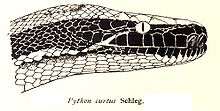Python curtus
Python curtus, commonly known as Sumatran short-tailed python, is a species of the family Pythonidae, a nonvenomous snake native to Sumatra.[1]
| Sumatran short-tailed python | |
|---|---|
 | |
| Scientific classification | |
| Kingdom: | Animalia |
| Phylum: | Chordata |
| Class: | Reptilia |
| Order: | Squamata |
| Suborder: | Serpentes |
| Family: | Pythonidae |
| Genus: | Python |
| Species: | P. curtus |
| Binomial name | |
| Python curtus Schlegel, 1872 | |
| Synonyms | |
|
Python breitensteini Steindachner, 1881 | |
Taxonomy

Python curtus was the scientific name proposed by Hermann Schlegel in 1872 for a python with a short tail from Sumatra.[2] The type locality is Sumatra.[3]
Description

The Sumatran short-tailed python has narrow subocular scales between the bottom of the eye and the top of the labial scales. The parietal scales do not join each other. P. curtus and P. breitensteini can be distinguished by the frontal and parietal scales on the tops of their heads. In both P. brongersmai and P. breitensteini, the parietal scales join. Adults grow to 1.5–1.8 m (4.9–5.9 ft) in length and are heavily built. The tail is extremely short relative to the overall length. The color pattern consists of a beige, tan, or grayish-brown ground color overlaid with blotches that are brick- to blood-red in color.[4]
Distribution and habitat
The Sumatran short-tailed python occurs in Sumatra, Riau Archipelago, Lingga Islands, Bangka Islands, Mentawai Islands and Kalimantan.[1] It inhabits rainforests, marshes, swamps, and the vicinity of river banks and streams.[4]
Diet
They feed on a variety of mammals and birds.[4]
Reproduction
Oviparous, females seldom lay more than a dozen large eggs (however, much larger clutches have been reported). The female remains coiled around the eggs during the incubation period, and may shiver to produce heat. However, this action requires energy and the female will only do so if surrounding temperatures drop below 90 °F. The hatchlings emerge after 2.5 to 3.0 months and are about 30 cm (12 in) in length.[4]
Uses
The species is kept as an exotic pet. They are often regarded as unpredictable and aggressive, but captive-bred individuals tend to be more docile than wild-caught specimens.
The Sumatran short-tailed python has been extensively harvested for leather; an estimated 100,000 individuals are taken for this purpose each year. The commercial trade regards this as a single species. Authors who elevate these island populations to species note that skins are readily distinguished.[5]
References
- Inger, R. F.; Iskandar, D.; Lilley, R.; Jenkins, H.; Das, I. (2014). "Python curtus". IUCN Red List of Threatened Species. IUCN. 2014: e.T192244A2060581. doi:10.2305/IUCN.UK.2014-1.RLTS.T192244A2060581.en. Retrieved 13 March 2018.
- Schlegel, H. (1872). "De Pythons". In Witkamp, P. H. (ed.). De Diergaarde van het Koninklijk Zoölogisch Genootschap Natura Artis Magistra te Amsterdam: De Kruipende Dieren. Amsterdam: Van Es. pp. 53–54.
- McDiarmid, R. W., Campbell, J. A., Touré, T. 1999. Snake Species of the World: A Taxonomic and Geographic Reference, vol. 1. Herpetologists' League. 511 pp. ISBN 1-893777-00-6 (series). ISBN 1-893777-01-4 (volume).
- Mehrtens, J. M. 1987. Living Snakes of the World in Color. New York: Sterling Publishers. 480 pp. ISBN 0-8069-6460-X.
- Keogh, J. Scott; Barker, David; Shine, Richard (2001). "Heavily exploited but poorly known: systematics and biogeography of commercially harvested pythons (Python curtus group) in Southeast Asia (abstract)". Biological Journal of the Linnean Society. 73 (1): 113. doi:10.1111/j.1095-8312.2001.tb01350.x. Archived from the original on 2013-01-05.
External links
| Wikimedia Commons has media related to Python curtus. |
- Python curtus at the Reptarium.cz Reptile Database. Accessed 11 September 2007.
- Borneo Blood information
